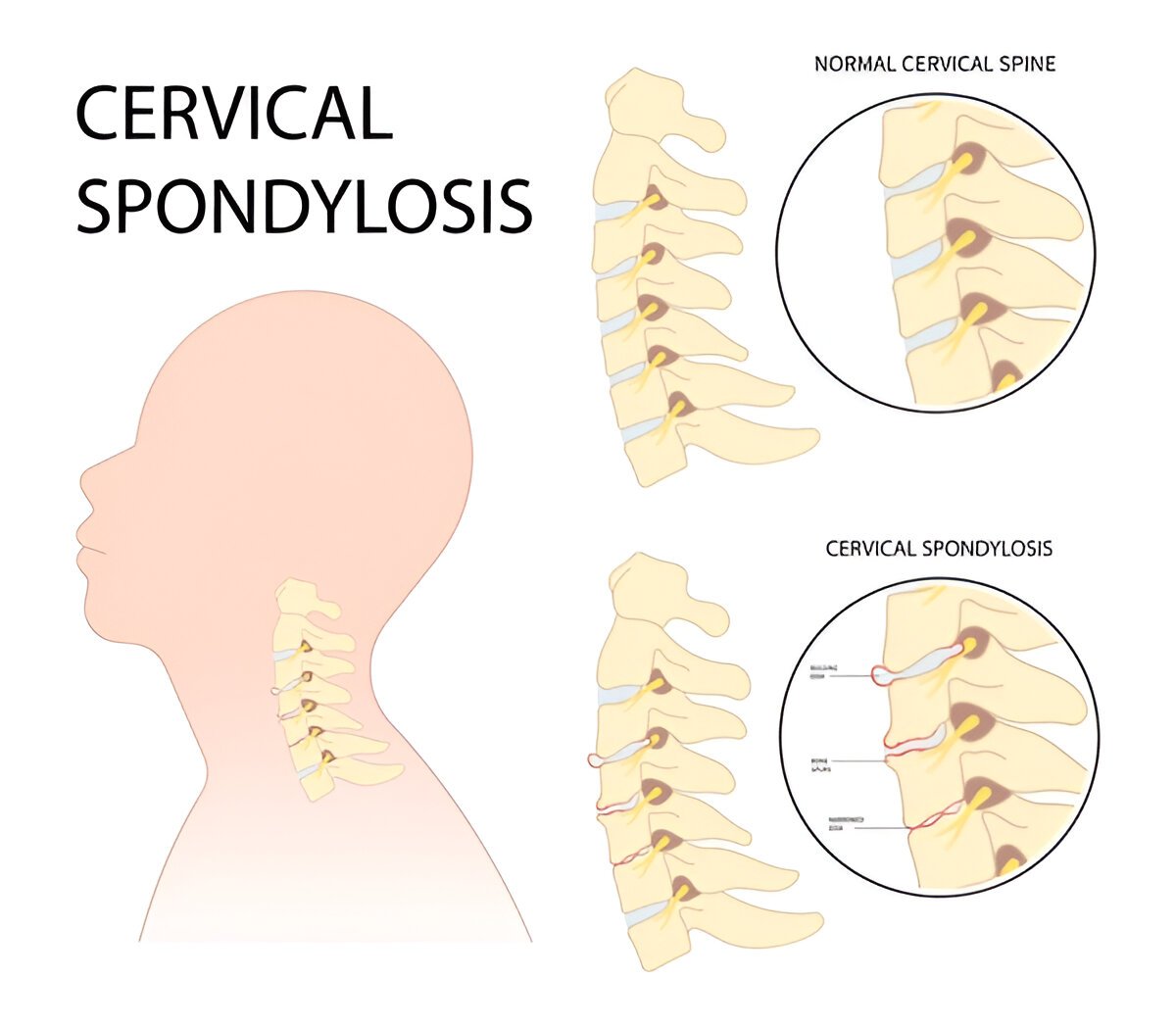Cervical Spondylosis
Neck stiffness that doesn’t go away. Headaches that start at the base of the skull. A dull ache that slides into your shoulders or arms. If this sounds like you, you may have cervical spondylosis, a very common condition caused by age-related changes in the spine.
Think of your cervical spine as a well-engineered column made up of bones, discs and joints. Over time these parts will wear out. The result? Pain, stiffness and in some cases, nerve irritation that affects daily life. At Rapid Physiocare, we specialize in helping patients manage these symptoms through evidence-based physiotherapy, proven techniques and long-term strategies that go beyond temporary relief.
What Is Cervical Spondylosis (Neck Arthritis)?
Another term for Cervical spondylosis is “neck arthritis.” As the discs lose hydration and cushioning, the joints stiffen and bone spurs may develop. While it’s a natural part of aging, modern lifestyles and hours of looking down at laptops or phones accelerate the process, and it’s becoming more common among people in their 30s and 40s.
It doesn’t always cause severe problems, but when it does, the tension can affect work, sleep and even simple movements like turning your head while driving. That’s when professional treatment is needed.

Cervical Spondylosis Symptoms
Symptoms vary depending on how much wear and tear has occurred and if nerves are involved. Common complaints are:
- Cervical pain and stiffness, especially in the morning or after long desk work.
- Headaches that seem to originate from the neck.
- Pain that radiates into the shoulders, arms or hands.
- Tingling, numbness or weakness in the arms or fingers.
- Difficulty with balance or coordination in advanced cases.
If any of these sound familiar, get a professional assessment to prevent it from getting worse.
Can Cervical Spondylosis Be Cured Permanently?
Patients ask, “How to cure cervical spondylosis permanently?”
Here’s the honest answer: the wear and tear changes can’t be reversed. However, with the right cervical spondylosis treatment, symptoms can be managed so well that most people live active, pain-free lives. The key is to relax the supporting muscles, improve posture and prevent further damage, just like how you service a car to keep it running smoothly even as it ages.

Physiotherapy for Cervical Spondylosis in Singapore
Physiotherapy treats the underlying causes, not just the pain. At Rapid Physiocare, our programs are adjusted to each patient’s needs. Here’s what you can expect:
- Manual therapy to restore joint mobility and reduce stiffness.
- Cervical spondylosis exercises to strengthen supporting muscles.
- Postural retraining for long-term neck and back health.
- Pain management techniques such as heat therapy, ultrasound or traction. Home programs with physiotherapy exercises for cervical spondylosis to prevent reoccurrence.
This will not only ease pain but also build resilience so your neck can keep up with daily stress without constant episodes.
Effective Cervical Spondylosis Exercises
Exercises are key to recovery. They are chosen based on your condition and progress. Examples include:
- Chin tucks to activate deep stabilizing muscles.
- Gentle neck stretches to release tension and increase flexibility.
- Shoulder blade squeezes to strengthen posture-supporting muscles.
- Isometric neck holds to build strength without strain.
These are not generic online routines; they are guided by our physiotherapists to ensure safe and effective results. Done consistently they reduce pain, improve mobility and prevent relapses.
Advanced Physiotherapy Options
For patients with persistent or severe symptoms, we add:
- Cervical traction therapy to relieve nerve compression.
- Shockwave therapy to stimulate healing in stubborn cases.
- Dry needling or myofascial release for chronic muscle tightness.
We also work with medical specialists when further imaging or treatment is required, for a seamless care pathway.
Why Choose Rapid Physiocare in Singapore?
Neck pain clinics are everywhere, but not all are the same. Here’s why patients choose us for cervical spondylosis physiotherapy:
- Spinal care expertise with years of experience in treating mild to complex cases.
- Personalized plans designed around your lifestyle, work demands and goals.
- Latest techniques based on research and best practices.
- Holistic approach that combines treatment, education and prevention.
- Multiple locations across Singapore, so expert care is convenient.
Our mission isn’t just to treat pain; it’s to help you take control of your health and prevent future problems.
Living Well With Cervical Spondylosis
Life with this condition doesn’t have to mean constant discomfort. With physiotherapy and healthy habits, most people live active lives without limitations. Here are some tips:
- Keep screens at eye level to avoid strain.
- Take short breaks every hour if working at a desk.
- Sleep with a pillow designed for cervical alignment.
- Stay active; movement nourishes the spine.
With professional care, these small changes make a big difference in long-term outcomes.
Get Started Today
Cervical spondylosis may be common, but that doesn’t mean you have to “just live with it.” Effective treatment exists, and the sooner you start, the better the results.
At Rapid Physiocare, we have helped thousands of patients in Singapore get back to pain-free living through a combination of physiotherapy, education and lifestyle strategies. Whether you’re in the early stages or dealing with advanced symptoms, we can help.
Don’t let cervical pain control your life. Book your appointment at Rapid Physiocare today.
Frequently Asked Questions
What should I avoid with cervical spondylosis?
Avoid anything that puts extra stress on your neck. Long hours at the desk without breaks, slouching while working, using very high pillows, or suddenly twisting your neck can make symptoms worse. Heavy lifting with poor posture and “neck cracking” habits should also be avoided. Instead, take regular breaks, keep good posture, and follow physiotherapist-guided neck exercises.
What triggers cervical spondylosis?
Cervical spondylosis is mainly triggered by age-related wear and tear in the spine. But lifestyle plays a big role too. Hours of looking down at laptops or phones, poor posture, old injuries, or physically demanding work can speed up the process. Stress and lack of regular exercise may also worsen stiffness and pain.
How should I sleep with cervical spondylosis?
The best way to sleep is with your neck well supported. Use a pillow that keeps your head in line with your spine, not too high, not too flat. Sleeping on your back or side is usually more comfortable than on your stomach, which strains the neck. A cervical pillow or memory foam pillow can help reduce morning stiffness.
What are the three stages of spondylosis?
Cervical spondylosis often develops in three stages:
- Stage 1 – Early changes: mild stiffness, occasional pain, usually after long hours of work.
- Stage 2 – Progressive wear: more frequent pain, reduced flexibility, possible nerve irritation.
- Stage 3 – Advanced: persistent pain, stiffness, tingling or weakness in arms, and sometimes balance issues.
Physiotherapy at the early stage helps slow progression and keeps the neck flexible and strong.
Can physiotherapy cure cervical spondylosis?
Physiotherapy doesn’t reverse the natural wear and tear, but it is the best way to control symptoms and prevent flare-ups. With the right program, manual therapy, posture retraining, and strengthening exercises, most patients live active, pain-free lives without constant discomfort.
What should you avoid if you have cervical spondylosis?
You should avoid poor posture, long hours without movement, lifting heavy weights incorrectly, and sudden jerky movements of the neck. Try not to use very thick pillows, and avoid looking down at screens for extended periods. Gentle, regular movement is better than complete rest.
What is the best treatment for cervical spondylosis?
The best treatment is a personalized physiotherapy program. This combines manual therapy to ease stiffness, targeted exercises to strengthen neck and shoulder muscles, and postural retraining to protect your spine. Pain relief techniques such as heat therapy, ultrasound, or traction may also be used. For stubborn cases, advanced options like shockwave therapy or dry needling can help. At Rapid Physiocare, treatment is tailored to your condition, lifestyle, and goals.

